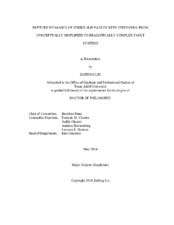Rupture Dynamics of Strike-Slip Faults with Stepovers: From Conceptually Simplified to Realistically Complex Fault Systems
Abstract
This dissertation investigates the interaction of model II in-plane dynamic rupture
with a geometrical discontinuity along the fault strike: stepover. One goal is to understand
how large the stepover width must be to stop the dynamic rupture, and whether the
maximum width is affected by the undrained pore pressure and the off-fault damage
during the coseismic process in conceptually simplified faults. In this research, we want to
understand the rupture dynamics in a realistically complex stepover, the Aksay double-bend
in the Altyn Tagh fault, and its ability to stop the dynamic rupture.
A detailed parameter-space study has been performed in the simplified model. From
the single fault test, I find that the Positive Coulomb Stress (PCS) region at the end of the
first fault controls the rupture initiation time and location on the second fault. The effects
of off-fault plastic deformation and undrained pore pressure on the rupture dynamics
within this simplified model have been discussed separately. The coupling effect of those
two effects has also been studied.
The possible correlation between the slip gradient nearby the first fault end and the
ability of the rupture to jump over the structure stepover in the strike-slip fault system has
been verified by my elastic models. I find that the slip gradients calculated over the final 1
km of fault have a linear relationship with both the corresponding average stress drop in
the fault system and the largest width of the step that could be jumped by the propagating
rupture.
In the model with realistically complex fault geometry, I use the slip and rate weakening law and the multi-cycle earthquake simulation method. I find that there are multiple rupturing scenarios that could occur within this complex fault geometry. My statistic analysis of the results of one-hundred-cycles’ simulations indicates that the Aksay bend successfully prevents nearly 90% events from propagating through it, which suggests that the Aksay bend works effectively as a barrier for coseismic ruptures. Viscosity in my models characterizes the effects of off-fault deformation on the faulting process. The results show that larger off-fault deformation strengthens the Aksay bend’s ability to stop a seismic rupture.
Citation
Liu, Zaifeng (2014). Rupture Dynamics of Strike-Slip Faults with Stepovers: From Conceptually Simplified to Realistically Complex Fault Systems. Doctoral dissertation, Texas A & M University. Available electronically from https : / /hdl .handle .net /1969 .1 /152609.


